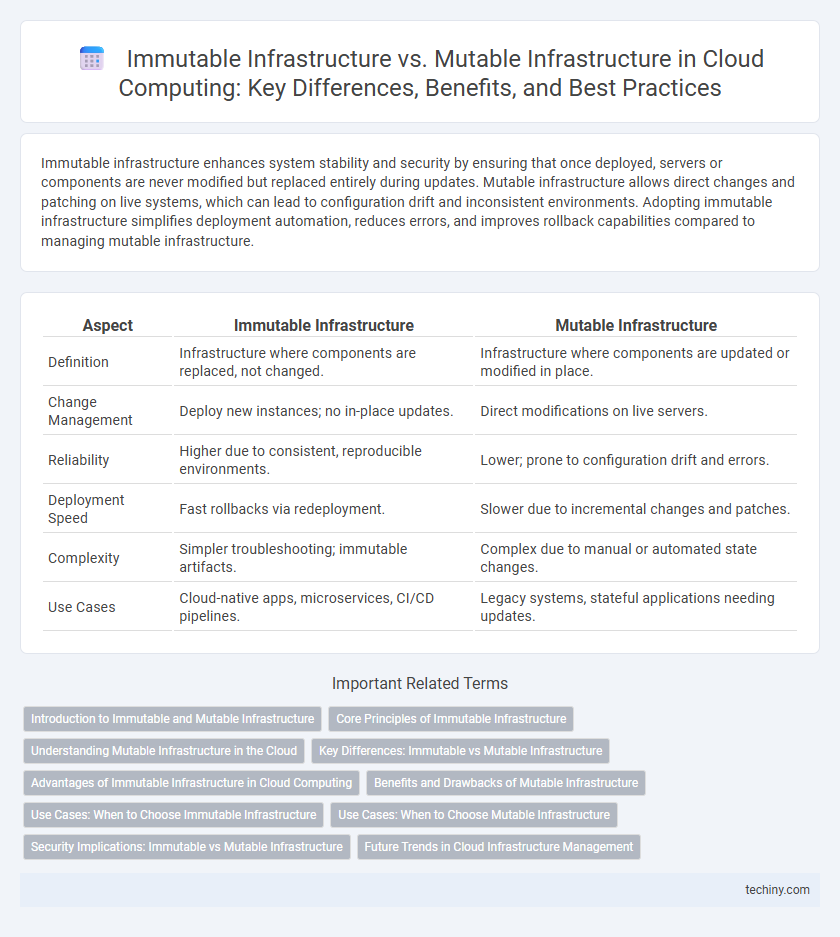Immutable infrastructure enhances system stability and security by ensuring that once deployed, servers or components are never modified but replaced entirely during updates. Mutable infrastructure allows direct changes and patching on live systems, which can lead to configuration drift and inconsistent environments. Adopting immutable infrastructure simplifies deployment automation, reduces errors, and improves rollback capabilities compared to managing mutable infrastructure.
Table of Comparison
| Aspect | Immutable Infrastructure | Mutable Infrastructure |
|---|---|---|
| Definition | Infrastructure where components are replaced, not changed. | Infrastructure where components are updated or modified in place. |
| Change Management | Deploy new instances; no in-place updates. | Direct modifications on live servers. |
| Reliability | Higher due to consistent, reproducible environments. | Lower; prone to configuration drift and errors. |
| Deployment Speed | Fast rollbacks via redeployment. | Slower due to incremental changes and patches. |
| Complexity | Simpler troubleshooting; immutable artifacts. | Complex due to manual or automated state changes. |
| Use Cases | Cloud-native apps, microservices, CI/CD pipelines. | Legacy systems, stateful applications needing updates. |
Introduction to Immutable and Mutable Infrastructure
Immutable infrastructure refers to IT environments where servers and components are never modified after deployment, ensuring consistency and reducing configuration drift. Mutable infrastructure, by contrast, allows changes and updates directly on live systems, enabling flexibility but increasing the risk of inconsistencies and configuration errors. Organizations prioritize immutable infrastructure to enhance stability, security, and automation in cloud computing environments.
Core Principles of Immutable Infrastructure
Immutable infrastructure ensures that servers or components are never modified after deployment, promoting consistency and reliability by replacing entire systems with updated versions. Key principles include version-controlled configurations, automated deployments, and infrastructure as code, enabling rapid rollback and minimizing configuration drift. This approach enhances security and scalability by treating infrastructure as disposable, reducing manual intervention and runtime errors.
Understanding Mutable Infrastructure in the Cloud
Mutable infrastructure in cloud computing involves allowing updates and changes to live systems through patches, configuration modifications, or scaling operations, enabling flexibility and immediate problem resolution. This approach often relies on configuration management tools such as Ansible, Chef, or Puppet to maintain system states, but can introduce configuration drift and complexity over time. Understanding mutable infrastructure requires recognizing its benefits in rapid iteration while managing risks related to inconsistency and troubleshooting difficulties.
Key Differences: Immutable vs Mutable Infrastructure
Immutable infrastructure ensures that once a server or component is deployed, it is never modified; any changes require replacing the entire instance, enhancing consistency and reducing configuration drift. Mutable infrastructure allows direct updates and modifications to live servers, enabling quick fixes but increasing the risk of configuration drift and inconsistencies over time. Key differences include deployment strategies, with immutable focusing on automation and version control, while mutable relies on manual or scripted changes, impacting scalability, reliability, and maintenance complexity in cloud environments.
Advantages of Immutable Infrastructure in Cloud Computing
Immutable infrastructure in cloud computing enhances system reliability by ensuring that server instances are never modified after deployment, which reduces configuration drift and simplifies rollback processes. This approach improves security by minimizing attack surfaces since deployed instances remain unchanged, and facilitates consistent testing and deployment through version-controlled images. Operational efficiency is increased as updates involve replacing entire instances rather than patching existing ones, leading to faster recovery times and streamlined automation.
Benefits and Drawbacks of Mutable Infrastructure
Mutable infrastructure allows direct updates and patches on live systems, enabling quick fixes and incremental changes without full redeployment. This flexibility can lead to configuration drift and inconsistencies over time, increasing the risk of errors and security vulnerabilities. Managing mutable infrastructure requires robust documentation and monitoring to maintain stability and ensure reliable performance.
Use Cases: When to Choose Immutable Infrastructure
Immutable infrastructure is ideal for environments requiring high reliability and consistency, such as continuous deployment pipelines and microservices architectures, where changes are deployed by replacing entire components rather than modifying them. It excels in disaster recovery scenarios and large-scale cloud environments like AWS or Azure, minimizing configuration drift and simplifying rollback processes. Organizations aiming for automated, predictable infrastructure management benefit from immutable infrastructure to improve security, reduce downtime, and streamline compliance.
Use Cases: When to Choose Mutable Infrastructure
Mutable infrastructure suits development environments where rapid iteration and debugging require real-time system modifications. It is ideal for legacy applications that depend on frequent updates and cannot be easily containerized or redeployed. Enterprises managing complex stateful applications, such as databases and tightly coupled services, benefit from mutable setups due to the need for continuous configuration changes.
Security Implications: Immutable vs Mutable Infrastructure
Immutable infrastructure enhances security by eliminating configuration drift and reducing attack surfaces, as servers are replaced rather than modified, preventing unauthorized changes and ensuring consistent system states. Mutable infrastructure poses higher security risks due to potential discrepancies in configurations and the difficulty in tracking unauthorized or accidental modifications over time. Automated replacement of immutable components supports rapid incident response and minimizes the window for vulnerabilities exploitation in cloud computing environments.
Future Trends in Cloud Infrastructure Management
Immutable infrastructure, characterized by fixed, unchangeable server instances, is gaining traction due to its enhanced security, consistency, and simplified rollback capabilities compared to mutable infrastructure, where servers are updated in place. Future trends indicate widespread adoption of Infrastructure as Code (IaC) and automation tools, enabling seamless deployment and rapid scaling of immutable environments in cloud-native ecosystems. Advances in containerization and serverless computing further drive the shift toward immutable infrastructure, optimizing resource management and minimizing configuration drift in cloud infrastructure management.
Immutable Infrastructure vs Mutable Infrastructure Infographic

 techiny.com
techiny.com